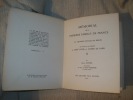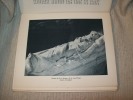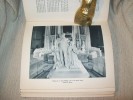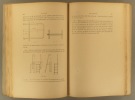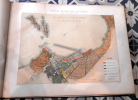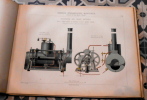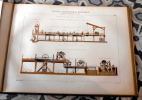-
Type
Any type (2)
Art print (7)
Book (31324)
Disk (1)
Drawings (7)
Engraving (9)
Magazine (125)
Old papers (1)
Photographs (14)
Posters (4)
-
Latest
Last 24h (7)
Last 3 days (38)
Last month (455)
Last week (41)
-
Language
Dutch (1)
English (52)
French (31397)
German (6)
Italian (18)
Portuguese (9)
Spanish (11)
-
Century
16th (15)
17th (56)
18th (213)
19th (1583)
20th (9537)
21st (1699)
-
Countries
Belgium (9489)
Brazil (7)
Canada (108)
China (1)
Côte d'Ivoire (66)
Denmark (218)
France (18493)
Germany (1)
Greece (1)
Italy (37)
Switzerland (3073)
-
Syndicate
ALAC (99)
CLAM (41)
CLAQ (94)
CNE (3)
ILAB (10920)
NVVA (1171)
SLACES (1171)
SLAM (8371)
SNCAO (9)
Rapports de classes et aménagement du territoire.
Couverture souple. Revue brochée. 173 pages.
Périodique. Revue critique de l'aménagement, de l'architecture et de l'urbanisation. Espaces et Sociétés, Mai 1974.
Le château espagnol du Moyen Age.
Madrid, Direction Générale des Relations Culturelles, 1949. 16 x 22, 39 pp., nombreuses illustrations en N/B, broché, bon état.
Cathédrales et monastères d'Espagne. Traduit de l'allemand ar Monique Bittebierre.
1965 Grenoble, Arthaud, 1965, in 8° relié pleine toile de l'éditeur, jaquette illustrée, emboitage carton, 340 pages.
Bel exemplaire. Illustré de 167 héliogravures ; carte dépliante in-fine. ...................... Photos sur demande ..........................


Phone number : 04 77 32 63 69
NOISY-LE-SEC
village heureux,village martyr depuis l’origine jusqu’à 1914 édition de 1955.Un volume grand in-8°.carré broché faux-titre,justificatif de tirage,titre,688 pages,2 feuillets;cartes,plans et tableaux dans et hors texte, illustrations dans le texte plus 2 tirés à part de 8 et 4 pages.Très Bon état.Reproduction d'un ouvrage paru en 1905,"prolongé jusqu'en 1914",et"étendu vers le plus lointain passé":préliminaires archéologiques et administratifs,puis étude historique des seigneuries(IXè-XVIè siècle),de la paroisse(Xè-XVIIIè siècles),et de la commune(IXè siècle-1914);suivie de notices sur la topographie,la voirie,les monuments et édifices publics, l'enseignement,l'administration et les divers services,les finances,la démographie et la condition économique de la population Noiséenne;avec nombreuses notes et citations de documents,fac-similés, plans,reproductions de gravures, photos;index thématique,des noms de personnes et des noms géographiques. Avec 2 tirés à part:recensement de 1954 et addenda.Première partie seule,seule parue? une suite concernant la période 1914-1950 étant annoncée).Tirage à 2000 exemplaires sur papier sur-glacé supérieur exemplaire n°217 Etui cartonné(avec un petit renfort) on joint deux lettre manuscrites de la mairie de Noisy Le Sec et une lettre d’un souscripteur
LA MAISON CARRE. Notice sommaire.
Nîmes Edité par la Société "Lens-Industrie" 1922. Plaquette in-8 brochée 54pp. Nombreuses illustrations dans le texte et hors texte. Les pages 45 à 54 reprennent ce texte en résumé, en langue anglaise.
La Société "Lens-Industrie" venait de reprendre l'exploitation de la carrière de Lens, déjà en activité dans l'antiquité romaine. Les blocs extraits de cette carrière servirent à la construction de la Maison Carrée de Nîmes, prise en exemple pour venter la bonne qualité, la beauté et la solidité de cette roche. (1632)
La Maison Carrée - Notice sommaire
Nîmes, Lens-Industrie, 1922. In-8 broché, 56 p. For English Notice, See p. 45. Illustrations. Très bon état.
L'AMPHITHEATRE DE NIMES
Henri Laurens. 1933. In-8. Broché. Etat d'usage, Tâchée, Dos fané, Intérieur acceptable. 86 pages. Illustré de nombreuses gravures et photo-gravures en noir et blanc dans et hors texte. Etiquette de code sur le dos. Tampons et annotation de bibliothèque sur le 1er plat et en page de titre.. . . . Classification Dewey : 720-Architecture
'Petites Monographies des Grands Edifices de la France', Collection fondée par E. Lefèvre-Pontalis, dir. par Marcel Aubert. Classification Dewey : 720-Architecture
La Tourmagne - Notice sommaire (Tour Magne)
NIMES, Imp. Générale (Gellion & Bandini) - 1927 - 3ème édition - In-8 - Broché - 2 figures NB dans le texte et 4 planches NB HT - 16 pages - Propre
- Livraison a domicile (La Poste) ou sur simple demande en Mondial Relay.- ATTENTION: Colis recommandé uniquement sur demande (parcel recommended on request). Si vous désirez un remboursement équivalent au montant de votre achat, en cas de perte détérioration ou spoliation, demandez-nous expressément un envoi en recommandé ( if you wish a repayment equivalent to the amount of your purchase, in case of loss - deterioration or despoliation, ask us expressly for a sending recommended)- Conditions de vente : Les frais de port sont affichés à titre Indicatifs (pour un livre) Nous pouvons être amené à vous contacter pour vous signaler le surcoût du au nopmbre de livres achetés ou du poids de ceux-ci. - Conditions of sale : The shipping costs are displayed as an indication (for one book) We may need to contact you to inform you of the cost of the additional shipping depending on the weight and the number of books- Possibilité d'envoi par Mondial-Relay - Réception en boutique sur rendez-vous. Librairie G. PORCHEROT - SP.Rance - 0681233148
Notice du baptistère Saint-Jean de Poitiers
POITIERS, E. Druinaud Lib.Ed. - 1890 - In-8 - Broché - Couverture illustrée - Illustrations NB dans le texte - 37 pages - Bon exemplaire
- Livraison a domicile (La Poste) ou sur simple demande en Mondial Relay.- ATTENTION: Colis recommandé uniquement sur demande (parcel recommended on request). Si vous désirez un remboursement équivalent au montant de votre achat, en cas de perte détérioration ou spoliation, demandez-nous expressément un envoi en recommandé ( if you wish a repayment equivalent to the amount of your purchase, in case of loss - deterioration or despoliation, ask us expressly for a sending recommended)- Conditions de vente : Les frais de port sont affichés à titre Indicatifs (pour un livre) Nous pouvons être amené à vous contacter pour vous signaler le surcoût du au nopmbre de livres achetés ou du poids de ceux-ci. - Conditions of sale : The shipping costs are displayed as an indication (for one book) We may need to contact you to inform you of the cost of the additional shipping depending on the weight and the number of books- Possibilité d'envoi par Mondial-Relay - Réception en boutique sur rendez-vous. Librairie G. PORCHEROT - SP.Rance - 0681233148
Révélations posthumes publiées par son frère et ses amis.
Nimes, Imprimerie Clavel-Ballivet, 1877, in 12 broché, 252 pages ; figures ; portrait photographique en frontispice ; quelques rousseurs ; couverture fanée, dos brisé.
Exemplaire enrichi d'un envoi autographe signé par "l'un des éditeurs". PHOTOS sur DEMANDE. ...................... Photos sur demande ..........................


Phone number : 04 77 32 63 69
MEMORIAL DE LA PREMIERE FAMILLE DE FRANCE. La chapelle royale de Dreux. Les Rois et les Princes de Saint Louis au Comte de Paris. Avant-propos du Duc de Lévis Mirepoix.
Paris Les Quatre Fils Aymon 1957. Grand in-8 en feuilles sous chemise cartonnée rempliée V 60pp 4 feuillets non chiffrés. Avec 2 tableaux généalogiques à pleine page et 12 belles héliogravures hors texte. 1 des 100 exemplaires numérotés sur Hollande. Petie coupure en tête de la chemise, intérieur frais en bon état, bien complet du texte et des illustrations.
Notions sur la construction des batiments
Ecole Spéciale des Travaux publics Paris Ecole Spéciale des Travaux Publics 1911, In-8 broché. 328 pages. Trés bon état.
Toutes les expéditions sont faites en suivi au-dessus de 25 euros. Expédition quotidienne pour les envois simples, suivis, recommandés ou Colissimo.
Notions sur la construction des bâtiments.
Couverture souple. Broché. 346 pages.
Livre. Cours revu et complété par Gaston Lefol. Editions Eyrolles, 1937.
Notions sur la constructions des bâtiments
Eyrolles Paris, Eyrolles, 1941. In-8 broché de 346 pages avec figures. Bon état.
Toutes les expéditions sont faites en suivi au-dessus de 25 euros. Expédition quotidienne pour les envois simples, suivis, recommandés ou Colissimo.
Notions sur la construction des bâtiments.
Couverture souple. Broché. 346 pages. Défraîchi. Traces d'humidité, manque au 2e plat.
Livre. Cours revu par Gaston Lefol. Nombreuses figures. Ecole spéciale des travaux publics, 1930.
Notions sur la construction des bâtiments.
Couverture souple. Broché. 346 pages. Couverture défraîchie.
Livre. Cours revu par Gaston Lefol. Nombreuses figures. Ecole spéciale des travaux publics, 1928.
Cours raisonné et détaillé du bâtiment. 10e partie : Distribution et installation d'ensemble d'un bâtiment.
Couverture souple. Broché. 520 pages. 3 planches dépliantes.
Livre. Cours revu par M. Gaston Lefol. Ecole spéciale des travaux publics, 1930.
CONSTRUCTION DES USINES ET DES ETABLISSEMENTS INDUSTRIELS
Ecole Spéciale des Travaux Publics. 1910. In-8. Relié. Etat d'usage, Couv. légèrement passée, Dos satisfaisant, Déchirures. 384 pages. Illustré de nombreux schémas et plans en noir et blanc dans le texte, et sur quelques grandes planches dépliables hors texte. Texte en caractères cursifs.. . . . Classification Dewey : 720-Architecture
(Rare) Ecole Spéciale des Travaux Publics, du Bâtiment et de l'Industrie, dir. par M. Léon EYROLLES. Elaboration d'un avant-projet. Murs en maçonnerie. Voûtes de caves. Charpentes métalliques. Monographies d'usines... Classification Dewey : 720-Architecture
Manière de rendre toutes sortes d'édifices incombustibles, ou Traité sur la construction des voûtes, faites avec des briques et du plâtre, dites voûtes plates, et d'un toit de brique, sans charpente, appelé comble briqueté.
Paris, Duchesne, 1754. In-12 de 80 pp. 2 grandes planches repliées (47 x 38 cm), veau marbré, dos orné à nerfs, pièce de titre en maroquin rouge, tranches rouges (reliure de l'époque).
Édition originale illustrée de deux planches gravées et repliées. Le comte Félix-François d'Espié (1708-1792), officier de cavalerie, gouverneur de Muret en 1748, entendait sécuriser l'architecture urbaine avec cette invention ignifuge, qui remplacerait les charpentes traditionnellement en bois, par des voûtes en brique et en plâtre. L'invention a été validée par le commissaire de l'Académie royale d'architecture de la ville de Toulouse en août 1753. Coiffes et coins frottés. Conlon, 54.656.
Pulcinella, dal contenuto al contenitore
Naples Colonnese 1994 In-12° (232 x 146 mm), [37] pp. - [1] f., broché, couverture à rabats, petit masque en matière plastique contrecollé au centre du premier plat de couverture.
UNE CURIEUSE COUVERTURE AGRÉMENTÉE D'UNE SCULPTURE. Édition originale et unique, avec envoi autographe signé avec dessin (masque de Pulcinella) « Parigi, 22.6.94 / A Gil / Lello Esposito », de ce catalogue paru à l'occasion de l'exposition « Pulcinella, dal contenuto al contenitore » organisée au Palazzo Marcelli de Valva en 1994. Un masque en relief de Pulcinella orne le premier plat de couverture. L'ouvrage est par ailleurs illustré de 11 reproductions en couleurs dont une en double-page (d'après des photographies de Cesare Accetta) de sculptures réalisées par Lello Esposito autour de la figure de Pulcinella, masque de Polichinelle de la commedia dell'arte napolitaine. Sculpteur, peintre, Lello Esposito a exposé à Naples, Rome, Budapest, Paris, New York et Tel Aviv ses oeuvres inspirées par la culture traditionnelle napolitaine. Son atelier est actuellement installé dans les écuries du Palazzo du Sangro. Un exemplaire en bibliothèque : Bibliothèque Antonio Labriala (Naples), fonds Antonio Ghirelli. Couverture légèrement salie.
Travaux Hydrauliques Maritimes – Construction du Bassin Napoléon à Marseille
Marseille, E. Cappeau del., 1861. Cartonné, 42 cm x 54,5 cm, LV planches en chromolithographies montées sur onglet par F. Canquoin. Ouvrage de Esprit Latour et Auguste Gassend. Couverture en état d’usage, planches en très bon état. Il manque les planches II et III et la page de garde, les planches XXVIII et XXXVI sont détachées. Rarissime
TRAITE ELEMENTAIRE D ARCHITECTURE - COMPLET 76 PLANCHES- COMPRENANT L ETUDE COMPLETE DES CINQ ORDRES - LE TRACE DES OMBRES ET LES PREMIERS PRINCIPES DE CONSTRUCTION
CH. MASSIN ET CIE. NON DATE. In-4. En feuillets. Bon état, Couv. convenable, Dos satisfaisant, Intérieur frais. 76 planches en noir et blanc. . Sous Emboitage. . Classification Dewey : 720-Architecture
Pierre Esquie fut un architecte du sud-ouest de la France. Grand Prix de Rome, il travailla avec Eugène Viollet-le-Duc. Classification Dewey : 720-Architecture
Traité élémentaire d’architecture comprenant l’étude complète des cinq ordres, le tracé des ombres et les premiers principes de construction.Ouvrage divisé en soixante-seize planches dessiné et mis en ordre par Pierre Esquié.
Paris, Ch. Massin sans date, 275x215mm, Cartable à ataches de l’éditeur. Bien complets des 76 planches. Bon état.
Pour un paiement via PayPal, veuillez nous en faire la demande et nous vous enverrons une facture PayPal
ESQUIE (Pierre) (Dessiné et mis en ordre par) / Gravé par STRASMANN
Reference : 16515
Traité élémentaire d'Architecture comprenant l'étude complète des cinq ordres, le tracé des ombres et les premiers principes de construction
Paris, Ch. Massin & Cie, s.d. In-folio : Ouvrage divisé en 76 planches volantes sous étui cartonné, fermeture à 3 lacets. Très bon état.Complet des 76 planches.
"Quartier cathédral - Une cité dans la ville (Collection ""Patrimoine vivant"")"
R.E.M.P.A.R.T. - Desclée de Brouwer. 1994. In-8. Broché. Bon état, Couv. convenable, Dos satisfaisant, Intérieur frais. 127 pages. Nombreuses photos monochromes dans et hors texte.. . . . Classification Dewey : 720-Architecture
"Collection ""Patrimoine vivant"", dirigée par André Châtelain. Classification Dewey : 720-Architecture"
 Write to the booksellers
Write to the booksellers




